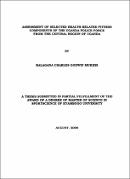Assessment of selected health related fitness components of the Uganda Police Force from the Central region of Uganda
Abstract
This study was conducted in the Police force from the central region of Uganda. The objectives
of the study were: to establish the fitness levels of the Uganda Police force with regard to
selected fitness variables and to ascertain the relationship between duty performance and the
selected fitness variables in the police force. Four (4) health related physical fitness components
were assessed and these are: Aerobic endurance, Flexibility, Strength endurance and Percent
body fat. The sample comprised of 60 subjects split equally between the Traffic police and the
Riot police departments. A pre-experimental research design was used in this study. Purposive
sampling procedure was employed in selecting the Police Departments. Stratified random
sampling procedure was used in selecting the subjects and simple random sampling technique
was used to choose the subjects per their duty stations, within the same department and of the
same gender. The results were then compared to the already established norms as published by
the American Alliance for Health, Physical Education, Recreation and Dance (AAHPERD
1985). Fitness tests for each of the selected fitness components were carried out and the data
obtained was compared with the norms as established by AAHPERD (1985). There after, the
data was analyzed using the analysis of variance (ANOV A) method in order to test the research
hypotheses. For the aerobic condition, 73.3% from the traffic police department and 53.3% from
the riot police department showed bad aerobic condition. For strength endurance levels; 60% of
the subjects from the traffic police department scored strength endurance levels below average
while 50% of the subjects from the riot police department scored above average. On the side of
flexibility scores; 66.6% of the total sample from the riot police department had flexibility scores
above the average mark while 50% of the total sample from the traffic police had their flexibility
scores above the average mark. The flexibility scores from both the riot and traffic police
departments therefore put all the subjects within the acceptable range. Body composition results
revealed that there was no subject that was over fat from both the riot and traffic police
department. It was recommended that regular fitness test programmes should be initiated in the
Uganda police force.

